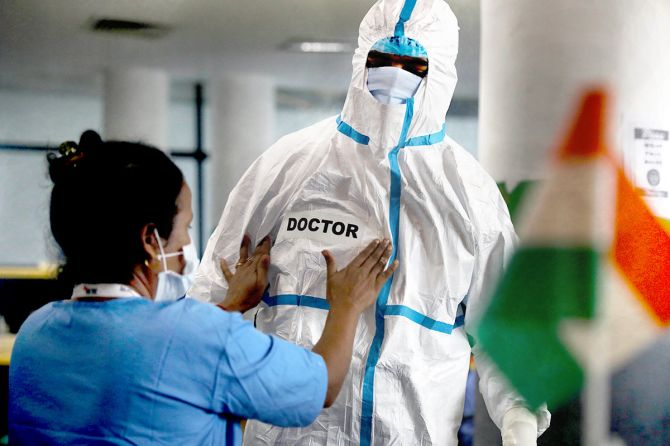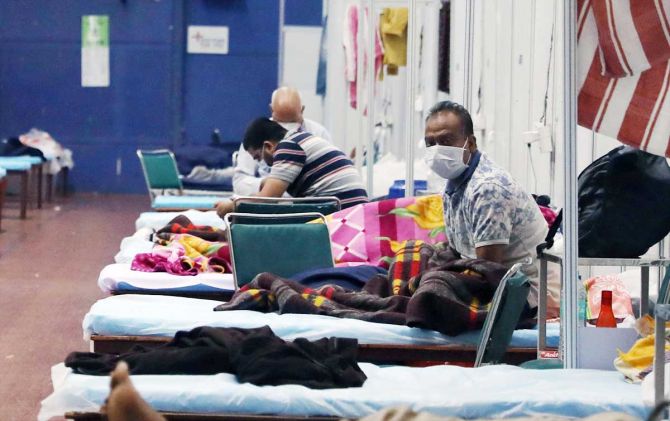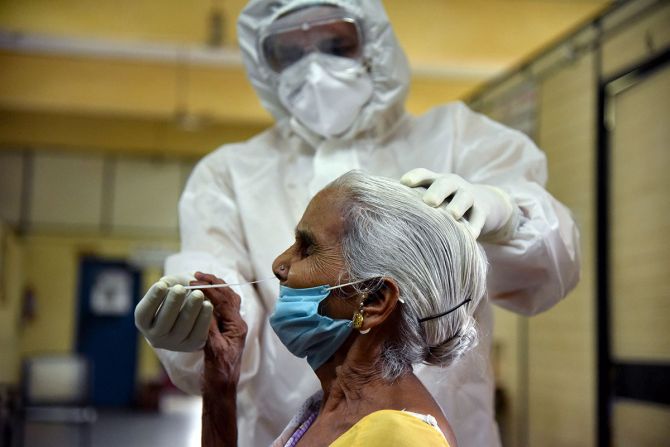'The genetic thing is not in your control. The virulence is not known.'
'The only thing is if you can avoid it.'
'Once you get COVID-19, none of it is in your control.'

IMAGE: A healthcare worker gets ready to check COVID-19 patients at the Commonwealth Village in New Delhi, August 19 2020. Photograph:ANI Photo
COVID-19 troubles Dr Anup Warrier.
Not for its virulence. Because he says COVID-19 is less lethal than past respiratory viruses of the same ilk, for instance, H1N1.
But for the attitudes surrounding it.
Like the mass hysteria that has greeted the aggressive bug.
Or how academicians have forgotten the absolute importance of scientific rigour in their speed to publish new data.
Dr Warrier speaks straight from the shoulder when he looks back at the realisations that have come to him since his medical journey with COVID-19 began six months ago.
He says primarily he was disturbed to discover that the academic and medical community abandoned best scientific practices in the speed to offer information that was often not up to the mark.
The clinical fraternity too, Dr Warrier feels, has been gripped by an unnecessary and unbecoming frenzy of misinformation and has begun to use "any number of drugs."
"They wouldn't pump a patient with five or six unproven drugs for any other disease on a routine basis," he adds.
The soft but blunt-spoken infectious disease specialist, who is a senior consultant, department of infectious diseases and hospital infection control, at the Aster Medcity Hospital in Kochi, has spent many years grappling with the larger consequences of various species of viruses, including the Nipah virus and HIV.
An interview with Vaihayasi Pande Daniel/Rediff.com:

IMAGE: A health worker collects swab samples for the COVID-19 Real-Time Polymerase Chain Reaction (RT-PCR) test in Gurugram, August 18 2020. Photograph: Yogendra Kumar/ANI Photo
Lesson One: Too much poor science
Surprisingly, for the sake of speed, the rigour of scientific evaluation or scientific assessment of a treatment, has been sacrificed during this time.
This is a little surprising.
Top medical journals like NEJM (New England Journal of Medicine) and JAMA (Journal of the American Medical Association) had to retract major scientific publications (papers).
After publishing a lot of flak was received from the scientific community and it was accepted that it (what was published) was substandard.
It was poor science which was published.
Even the top journals -- NEJM is supposed to be one of the very well-respected medical journals in our community -- they had to retract because they published poor science.
This is something which is surprising.
That such journals would actually fall for the need to publish anything for speed and forgo putting things through the rigour of science, as they would have done for other standard publications (in normal times).
It is not right. There are no circumstances which justify putting out information which is inherently false.

IMAGE: A COVID-19 patient at the Commonwealth Village in New Delhi, August 19 2020. Photograph: Prabhat Mehrotra/ANI Photo
Lesson Two: Mass hysteria by the medical community
From the clinical community, from the practicing doctors' side, what we saw was mass hysteria.
They found themselves confident in using all sorts of unfounded and unproven medications based on anecdotal evidence.
I have seen prescriptions for a COVID-19 patient, which contains five to six drugs, all of them unproven.
At least the clinical doctors, academic centres and institutes, that take pride in their prescriptions adhering to the available knowledge and regular practice globally.
But during this time, we saw that even in those high academic centres and very good institutes, for a lot of doctors -- obviously, primarily because, I believe, it was more out of more of a mass hysteria -- whatever was published in whatever medical literature, as a possible cure, found its way into actual patients' prescription, without looking at either the basic science rationale, nor evidence of clinical efficacy.
There is a lot of hurry among the medical community to use whatever, though we have seen that, after rigorous clinical trials, all these new drugs have failed, like remdesivir and tocilizumab.
Starting from vitamin C, vitamin D and zinc supplementation, which in another scenario most modern doctors would put down to quackery (were prescribed).
They found a permanent place in medical guidelines -- the local guidelines, guidelines of societies of the local IMAs (Indian Medical Associations) and in many of the state COVID-19 management guidelines, like Karnataka state.
People have put it down on paper about giving vitamin D supplementation etc.
We call it nutraceuticals.
It is more on the fringe of modern medicine, not mainstream modern medicine.
Nutraceuticals are when you use nutrient supplements to improve, prevent or cure diseases.
With this thing (the arrival of COVID-19) it has become mainstream with state government guidelines prescribing vitamin C and zinc, and what all, for treating COVID-19.
There is a lot of paranoia, a lot of mass hysteria about whatever comes out (on COVID-19).
Somebody just talks out of his head that this could be useful (and people listen) and you can write anything and it will be get published.
If you look at the number of publications, which have happened in the last six months on COVID-19, it is humongous.
Everybody who wanted to have some publication under their name, they could have added (written) anything about COVID-19 and all the so-called unusual manifestations which have been attributed to COVID-19 -- the blood clots, the ARDS (Acute Respiratory Distress Syndrome), the happy hypoxia*.
When you look at it very rationally, without much of the hype (associated with) COVID-19, you will see that all the manifestations and major complications, which have been described -- other than maybe the loss of smell and taste (anosmia), which I have not really looked into in that much detail -- like pneumonia, the ARDS (Acute Respiratory Distress Syndrome), the blood clots, the happy hypoxia (the sensation of low oxygen levels being absent) all these have a perfectly rational explanations.
And they have been found in all the previous viral pneumonias also including H1N1 (the pandemic that began in 2009).
If you look at the publications, for H1N1 you find exactly the same kind of data on blood clots, hypoxia and all those things.
But somehow these are all -- even in the medical fraternity - put up like something unique for COVID-19.
Like people are seeing this for the first time.
They are not.
Even in 2009 H1N1 epidemic, all these were published.
These are all things which are preexisting, which happened with other diseases and which people always were dealing with for many years in the past.
The only difference between the previous pandemics is the scale.
This was obviously on a much larger scale, which sort of pressurised the healthcare system in terms of capacity.
So, the challenge here was capacity.
It was not primarily a clinical challenge.
If you look at the published mortality: The number of people who died after developing ARDS or severe pneumonia from H1N1 was actually higher than the number of people who developed ARDS or severe pneumonia from COVID-19 -- the actual deaths, because that is something which people cannot fool around with, because you know how many people died.
That's the reason I am saying, overall, there is too much hype about the novelty of COVID-19's presentation or its severity.
(What's different about COVID-19) is more to do with the scale of presentation and the challenges to the healthcare capacity, rather than an actual clinical challenge.
It is also the absolute numbers.
It's not that in Europe and US the healthcare systems were overburdened with H1N1 (like they were for COVID-19).

IMAGE: 103-year-old Purakatt Veettil Pareed leaving the government hospital after getting COVID free in Kochi, August 19 2020. Photograph: Kbjaya Chandran/ANI Photo
Dr Anup Warrier answers two more questions:
The situation in Kerala
In August, we have treated about 25 to 30 odd cases.
And out of that 25 to 30, just about maybe five or six could be on the more ill side, meaning requiring ICU care and all, and there was one death among that.
We have stuck to the Government of India clinical management protocol.
We have not used remdesivir.
We have not used tocilizumab, at all.
Our team here is quite comfortable sticking to what the Government of India guidelines and not going beyond or not using any experimental therapy.
Previously, overall in the state, cases were less than 100 or sometimes rarely 100 per day.
Over the last four days, it has been touching 1,000.
Especially in the last one week to 10 days now (early August).
Right now, almost, on a daily basis, we have between 800 to 1,200 new cases.
We have two or three large clusters.
Now these are not from expatriates or people who have come back.
These are all local transmissions.
Previously among 100 new cases, eight would be people who are coming from other states and other countries.
Now among our 1,000 cases, 800 are local transmission.
Not from outside.
Definitely, there is a lot of local transmission in the state.
The largest cluster is in Trivandrum, where they are reporting between 250 to 300 cases, on a daily basis.
The second cluster is in Malappuram, where it si reporting around 100 odd cases.
The third is in Ernakulam -- where we are reporting around 70 to 100 new cases.
Now the time of contact tracing is probably past. There is significant local transmission.
Previously, when you had somebody coming in from outside, then from him you trace the contacts and you could isolate.
That was an efficient or effective method when it was limited to expatriates and local transmission was very less.
Now 80 per cent is local transmission.
Even out of that, every day, we are we have around 25 to 30 or more people, whose source of illness cannot be traced at all.
So, contact tracing will not be an effective strategy now in this phase.
Right now, what the government is doing is that it is going for cluster containment.
Wherever a group of cases have been identified together, they're shutting down that area -- limiting traffic from that area to other areas and then doing mass screening and testing in that zone.
Kerala is a little unique.
We don't have that traditional Indian thing of rural-urban divide.
Our access to healthcare is almost uniform.
Barring a few hilly areas in Idukki and rural areas in Wayanad, 88 per cent of the population has extremely good access to health care.
And we have large medical colleges.
It is a small state also.
There is a uniform testing across all districts.

IMAGE: A healthcare worker gives tea to a COVID-19 patient at the Commonwealth Village in New Delhi, August 19 2020. Photograph: ANI Photo
Why do some families suffer COVID-19 much worse than others?
One could see that the Bachchan family got a mild case, even if age was not on their side, while others much more sick?
Why is it different family to family?
It's like that for any viral illness.
One of the oldest viral illnesses in India, with which we are very, very familiar, is dengue.
It has been around for more than a decade, 20 years at least in India.
Many of us have got dengue or know people who got dengue.
It is the same with dengue.
Some people have just a mild body pain and fever and they get tested and they are found to have dengue.
But that's it. They're at home. Nothing happens.
There will be another group of people who are found to have dengue and they have a lot of rash all over their body.
Their platelet count falls precipitously.
They are admitted and they're given platelet transfusion.
But then that is it. And they get back home.
Then there is a group of people for whom the platelet count drops and they bleed extensively, their BP gives away and the healthcare services and the doctors are unable to save them and they die.
Similarly, for flu. All of us get flu.
Most of us just manage it and maybe sit at home for two or three days.
And then we have people, including young people and pregnant women, who are very badly affected and who are prone to developing pneumonia require hospitalisation and then ventilation, etc etc.
What I'm trying to say is that this is exactly how it is for any infectious disease.
You have the clinical presentation -- of how a patient would behave, what would be the severity, what would be the outcome.
It is a function of treating and it as a function of the virulence of that strain.
In that locality, and in that time, it would be mostly standardised, right.
You can't expect that in Bombay, Amitabh Bachchan would get a different strain than the others.
It is mostly standardised in the same zone for the same time.
Then you have the host's response ie the immune response of the host.
That is genetically determined.
Any depends also on the other diseases or comorbid conditions this person might have.
So, that is a very, very individual and it would vary from person to person.
And the third is the access to healthcare and what is the sort of management they get.
The management they get could go either way -- it could alter the first response or it could alter the virulence also.
Like you give somebody some medicine which is not good for his immune function or alters his immune function, that could be a reason and or it could be a medicine which actually enhances the potency of the virus.
That is also possible.
These are the three things which sort of determine how a disease could progress in a person.
In spite of that, we know that between one family and the next family the viral effect is more or less the same.
When I say virulence that is what I am saying, the ability of the bug to induce an adverse response and the amount of viral load he has managed to get.
Globally they have found that the risk for healthcare workers is more because when during certain procedures in the hospital, intubation etc, they're exposed to higher viral load than normal people.
But in routine activities -- like talking to somebody face to face or you come across somebody in the market -- there I would not expect a major difference in the viral load exposure.
(On whether the viral load is higher if the person sick is your neighbor opposite) not really.
The viral load depends on an aerosol generation.
If you talk to somebody, face to face, or somebody is living next door, (you have to consider) the amount of air dilution.
If he puts one lakh viruses into the environment, it goes into a million cubic feet of air, na?
And then we know that in regular homes, with windows and all, our air exchange rate for about 30 to 35 per hour and it would fast get washed out.. It means the whole air in a room is replaced 30-35 times in an hour, if there are open windows and good ventilation.

IMAGE: A health worker in personal protective equipment collects a swab sample from a woman at a health centre in the Kashmere gate area in Delhi, August 19 2020. Photograph: ANI Photo
So, the factors that make the disease worse for one person and not so bad for another are not in your control?
The genetic thing is not in your control. The virulence is not known.
The only thing is if you can avoid it.
Once you get COVID-19, none of it is in your control.
*A silent hypoxemia (dangerous decrease in oxygen in the blood) where people seem to be functioning without any issues and without, sometimes, shortness of breath.
Feature Presentation: Ashish Narsale/ Rediff.com








